Digital Dental X-Rays
Dental X-rays for clear dental diagnostics.
Ensure effective and timely treatment with digital dental X-rays at our Jackson Square Mall dentist office.
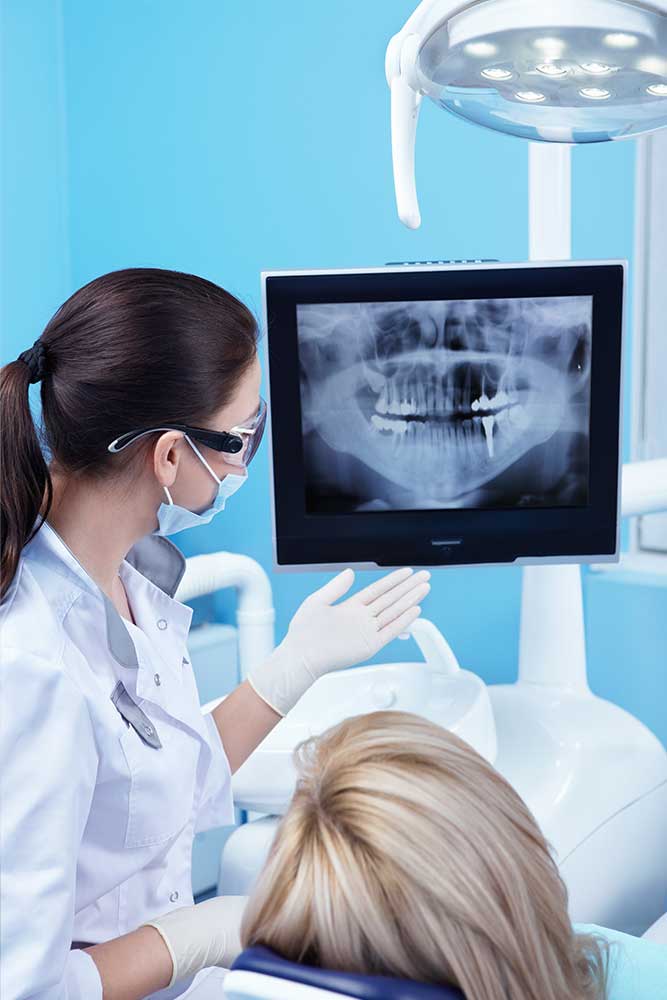
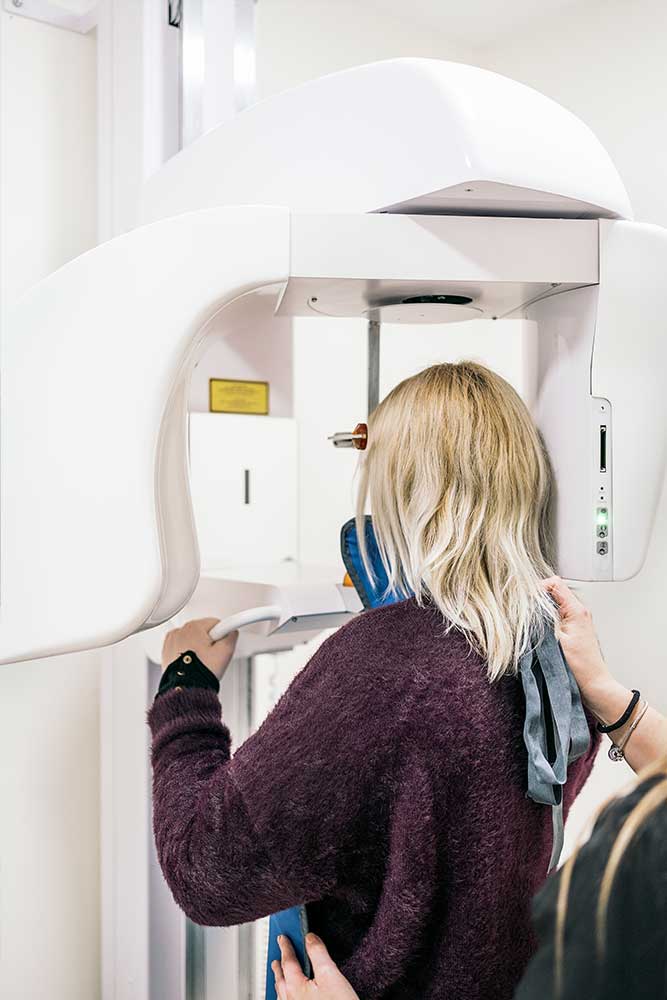
Always digital.
Always safe.
Overview
Our dentists use dental X-rays as diagnostic imaging tools to provide a detailed view of the teeth, bones, and soft tissues of the mouth that are not visible to the naked eye during a regular dental exam.
What is the purpose of dental X-rays?
Dental X-rays help our dentists diagnose and treat dental problems at an early stage, to help ensure better oral health outcomes. These X-rays can reveal hidden dental structures, cavities, bone loss, and various tooth and gum issues that are otherwise difficult or impossible to see.
Types of dental X-rays we use
At our Hamilton dental office, our team uses several different types of dental X-rays depending on the specific purpose of a diagnosis or treatment.
Bitewing X-rays
Probably the most common X-ray we use, these show the upper and lower back teeth in a single view. They are used to detect decay between teeth and changes in bone density caused by gum disease. They are also useful for determining the proper fit of a crown or other restorative device.
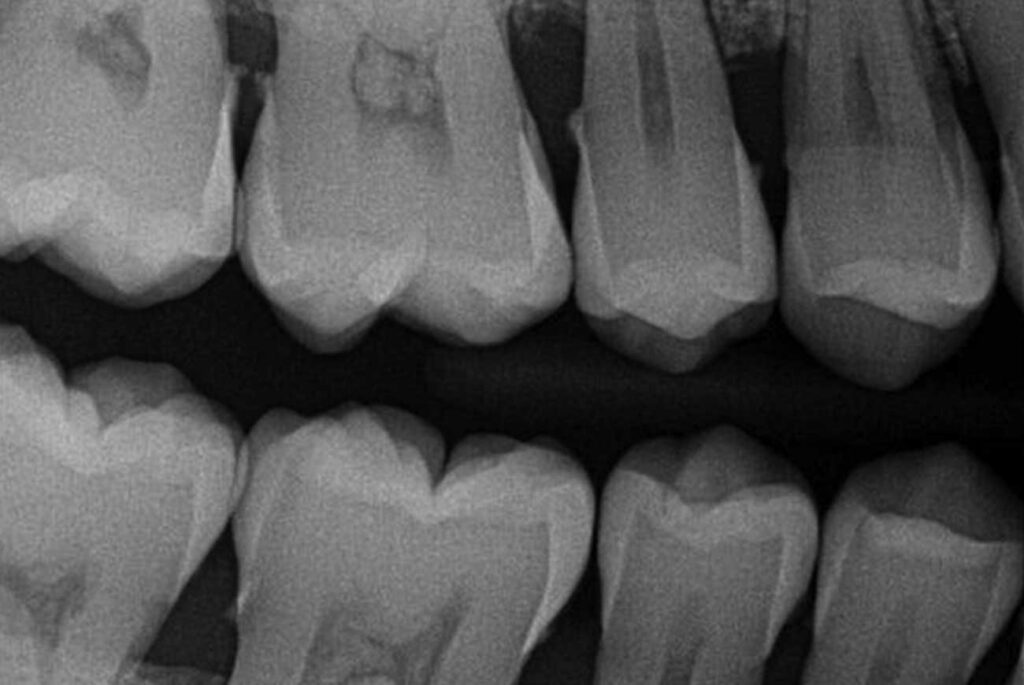
Panoramic X-rays
These capture an image of the entire mouth area, showing all the teeth in both upper and lower jaws in a single X-ray. They are useful for detecting impacted teeth, cysts, tumors, jaw disorders, and bone irregularities.
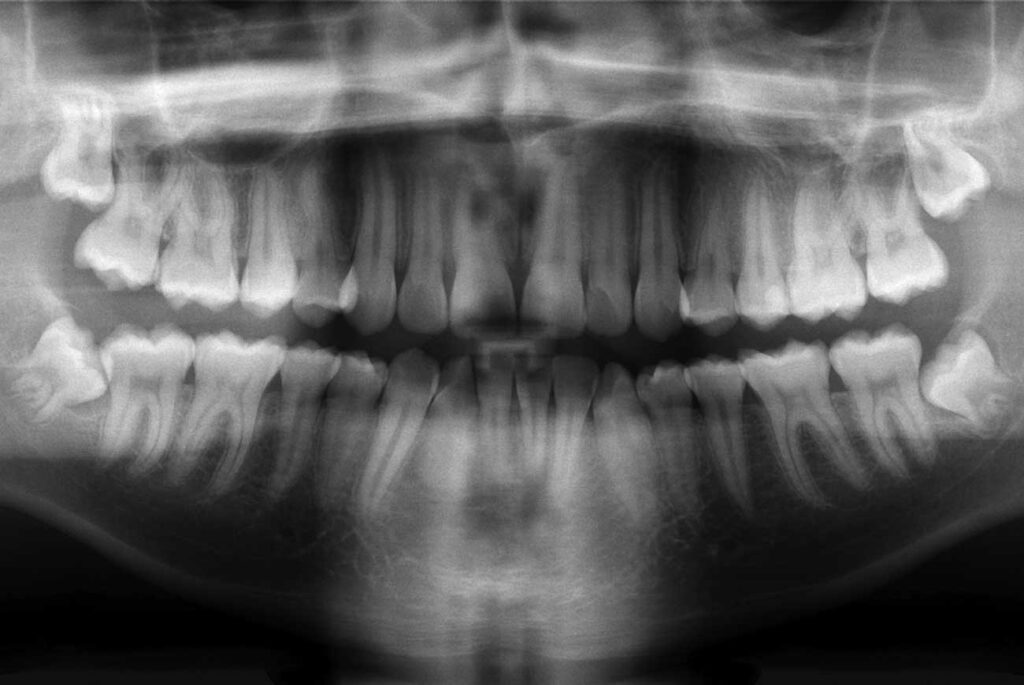
Periapical X-rays
These provide a view of the entire tooth, from the crown to beyond the root where the tooth attaches into the jaw. Periapical X-rays are used to detect dental problems below the gum line or in the jaw, such as impacted teeth, abscesses, cysts, tumors, and bone changes linked to some diseases.
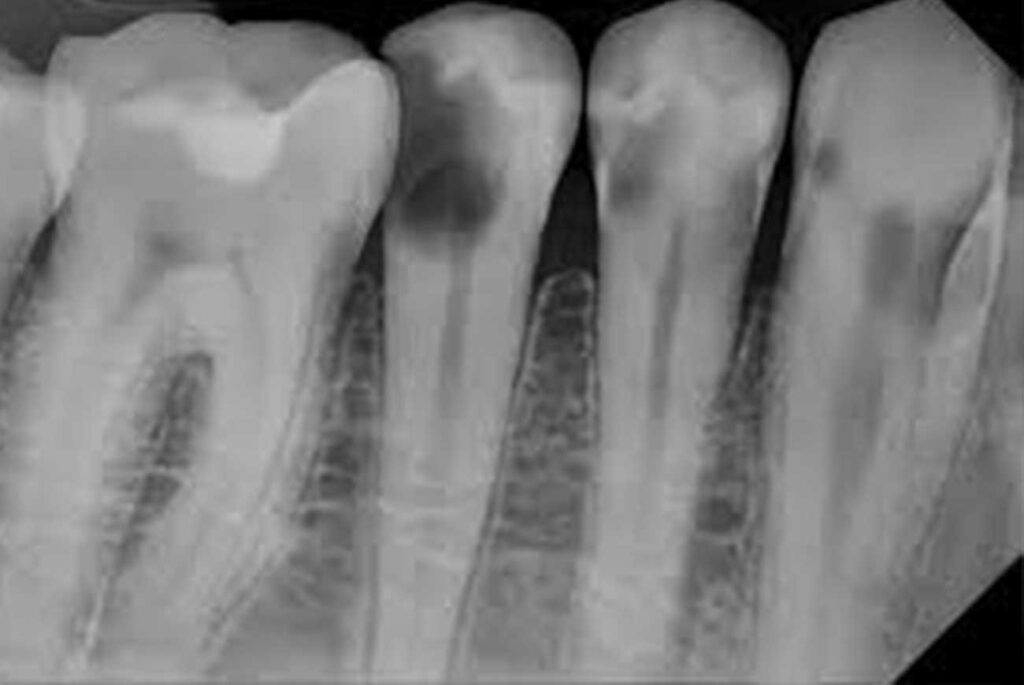
Occlusal X-rays
They are larger and show full tooth development and placement in the upper or lower jaw. These are used to detect the presence of extra teeth, teeth that have not yet broken through the gums, jaw fractures, cleft palate, cysts, abnormalities, or growths.
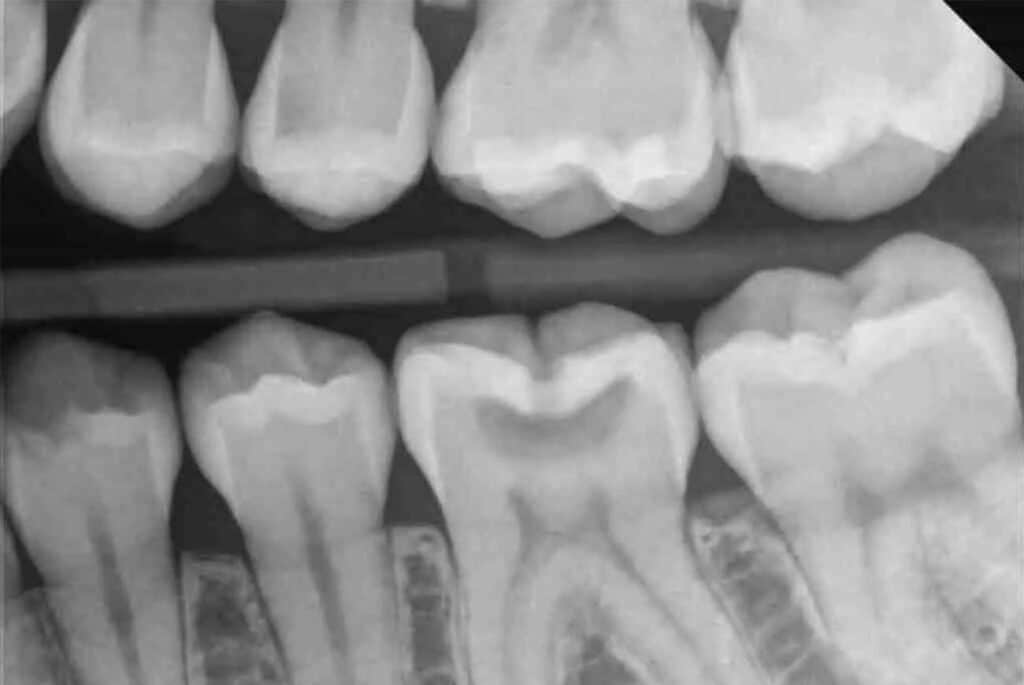
Orthodontic (Cephalometric) X-rays
These are commonly used by our orthodontists when planning a treatment schedule because they provide a side view of the face, showing the teeth in relation to the jaw and profile of the individual.
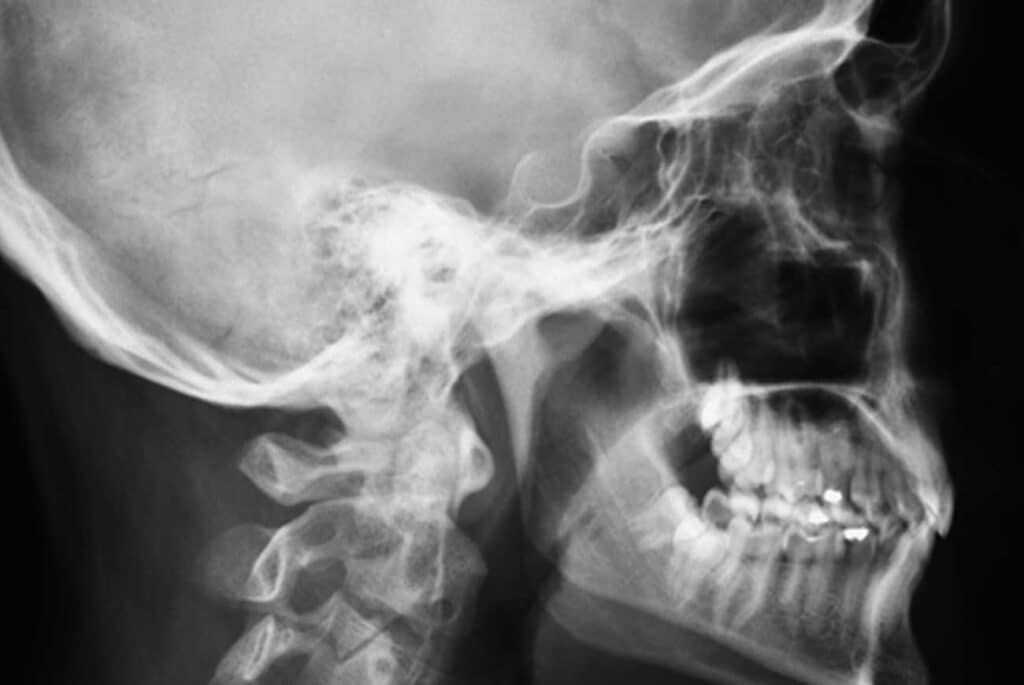
Cone Beam Computed Tomography (CBCT)
Our most advanced dental X-ray, this technology produces 3D images of the teeth, soft tissues, nerve pathways, and bone in a single scan. It’s used for more complex cases such as implant planning, evaluation of the jaw, sinuses, nerve canals, and nasal cavity, and for detecting and treating orthodontic issues.
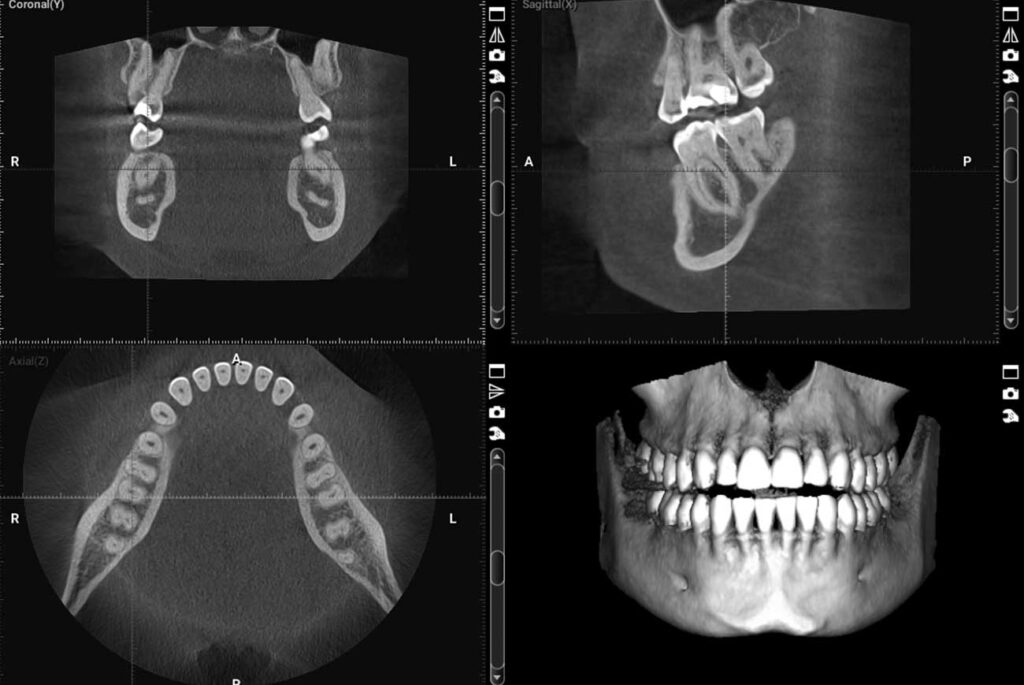
We use only digital dental X-rays
Our office uses only digital X-rays due to the greatly reduced radiation exposure (90% less than traditional film X-rays), instant imaging, better image quality, easy integration and storage with modern dental software and health records, and they allow us to educate our patients about what’s going on with their mouth.
Benefits of dental X-rays
Dental X-rays offer several valuable benefits to our dentists and patients. One of the primary advantages is their ability to detect dental issues at an early stage. X-rays can reveal conditions like cavities, gum disease, and infections before they become more severe, allowing for timely intervention and treatment.
The most common use for dental X-rays is to check for or confirm the presence of tooth decay in-between teeth.
Additionally, they provide a detailed assessment of tooth and bone health, offering insights into the condition of tooth roots and the surrounding jawbone. This is crucial for diagnosing problems such as abscesses and bone loss.
Dental X-rays are also vital in treatment planning, so that our dentists are able to precisely perform intricate procedures such as extractions, root canals, dental implants and orthodontic treatments where the jawbone and oral nerves must be navigated and accounted for.
Dental X-rays and your safety
All digital dental X-rays we use at our Hamilton clinic are designed and operated with a strong emphasis on patient safety. The use of electronic sensors, customization of exposure settings, immediate imaging, and image enhancement techniques contribute to the safety of digital dental X-rays. Our dental professionals adhere to established principles of radiation safety and quality control to ensure that patients receive the necessary diagnostic information with minimal radiation exposure.
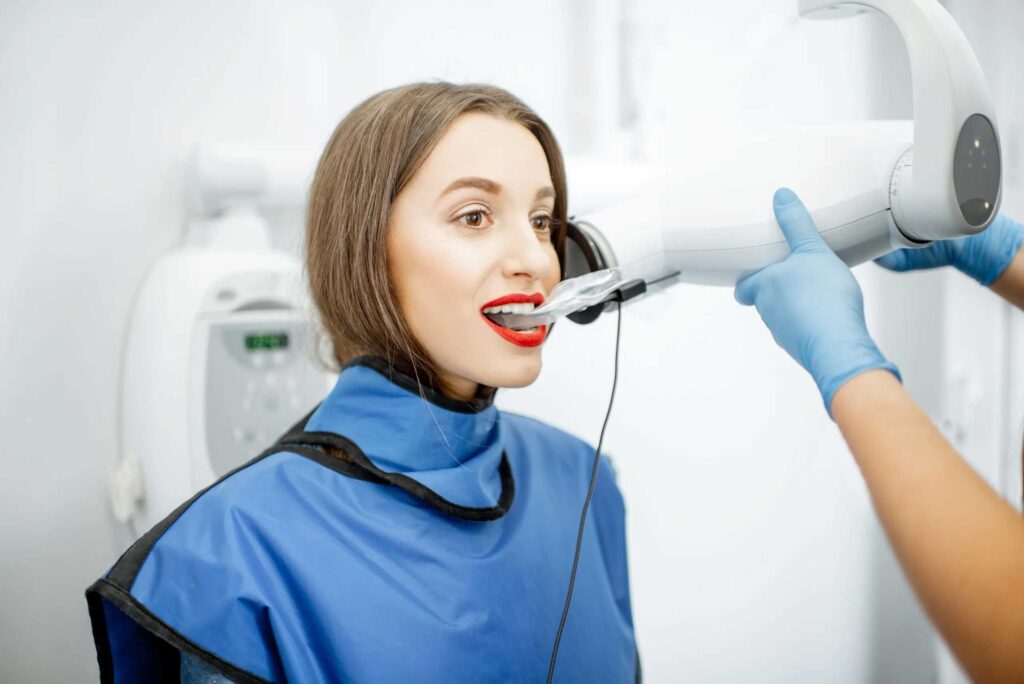
The dental X-ray procedure
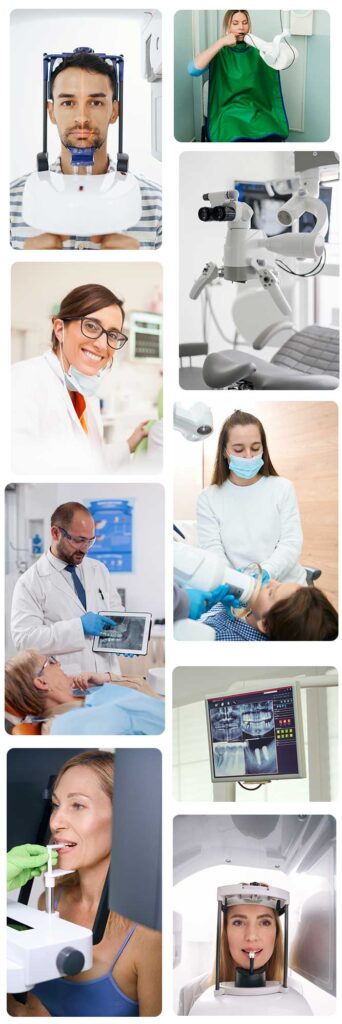
The patient is prepared for the X-ray procedure by wearing a lead apron to protect against radiation exposure. A lead thyroid collar may also be provided for added protection of the thyroid gland.
The dental professional will explain the procedure to the patient, including the need to remain still during image acquisition.
Dental X-rays are often done right in the dentist chair or in another area of the clinic.
The patient is positioned in the dental chair, and the X-ray machine (X-ray generator) is adjusted to the appropriate settings based on the type of X-ray needed.
Depending on the specific X-ray being taken, the patient may be asked to bite down on a small, rectangular piece of plastic with a sensor (digital X-rays) or a film (traditional film-based X-rays). This sensor or film captures the X-ray images.
The dental professional, usually a dental hygienist or dental assistant, leaves the treatment room to stand behind a protective barrier.
They activate the X-ray machine, which directs a controlled beam of X-rays at the area of interest (e.g., a specific tooth or section of the mouth).
The X-ray machine emits a brief burst of X-rays, and the sensor or film captures the images.
Depending on the type of X-rays required, the dental professional may reposition the sensor or film to capture images from different angles or perspectives.
Additional X-ray exposures may be taken as needed.
For digital X-rays, the images are processed almost instantly and displayed on a computer screen in the treatment room.
The dental professional reviews the images to ensure they are clear and sufficient for diagnosis.
Additional X-ray exposures may be taken as needed.
The dental professional reviews the X-ray images to assess the patient’s oral health. They look for signs of dental decay, gum disease, bone loss, and other dental conditions.
The X-rays may reveal issues not visible during a clinical examination alone.
The findings from the X-rays are discussed with the patient. If dental issues are identified, the dentist will explain the treatment options and develop a treatment plan.
The X-ray images are documented in the patient’s dental records for reference in future appointments. They become part of the patient’s dental history.
How often do we recommend dental X-rays?
We try to minimize the number of dental X-rays we recommend to our patients unless an issue or treatment would benefit from having X-rays done. As such, the frequency of dental X-rays will vary from patient to patient, often being determined by age, oral health, risk factors, and specific dental issues.
We will generally recommend dental X-rays under the following conditions:

It’s a patients first visit: This helps us determine a baseline for future comparison and let’s us know the current state of a patient’s oral health so nothing gets missed.

An issue needs diagnosing: Sometimes there will be a potential issue that needs further investigation with a dental X-ray. It can be something as simple as a cavity between a patient’s teeth.

The patient is a child or adolescent: We often recommend dental X-rays more frequently to minors because their teeth and jaw structures are still growing and changing, making monitoring more important.

Patients with periodontal health problems: Patients with gum disease may require more X-rays in order to assess the health of their underlying jawbone.

Orthodontic patients: Patients undergoing orthodontic treatments (braces, aligners, retainers) often need X-rays to monitor the treatment progress and position of teeth and roots. This ensures that the treatment plan adjusted correctly.
Our expertise
Our experience
Our quality
Our skilled dental professionals and staff are experts in crown and bridge procedures. Our office specializes in restoring and enhancing smiles using the latest techniques and technology to ensure functional and aesthetically pleasing dental restorations.
Our team has the experience to provide personalized solutions that blend seamlessly with your natural teeth. From the first consultation to the final fitting, our team knows how to make the procedure process hassle-free and successful.
We understand the importance of function and aesthetics, which is why we use only the highest-quality materials and cutting-edge techniques. Our smile restoration work ensures every patient leaves our clinic with a stronger, more beautiful smile.
Dental X-ray FAQ
Yes, dental X-rays are safe when used following established guidelines. The radiation exposure is minimal and carefully controlled to prioritize patient safety.
The frequency of X-rays depends on your oral health needs and risk factors. Dentists typically recommend them at routine check-ups or as needed for diagnosis or treatment planning.
Dental X-rays can detect various oral issues, including cavities, gum disease, infections, bone abnormalities, impacted teeth, and oral tumors.
Dentists may recommend X-rays during routine check-ups to monitor your oral health and detect any hidden issues. The frequency depends on your individual dental health.
Dentists usually avoid routine X-rays during pregnancy. However, if X-rays are necessary for diagnosis or treatment, they will use protective measures to minimize radiation exposure.
Yes, digital X-rays use much lower radiation doses than traditional film-based X-rays, making them a safer option. They also offer immediate image display and can be integrated into our dental software and easily stored or shared.
No, dental X-rays are painless. You may feel the sensation of the X-ray sensor or film in your mouth, but it is not uncomfortable.
X-rays for children are recommended based on their specific dental needs and development. Dentists use lower radiation doses for pediatric X-rays.
Yes, of course. We can show you the X-ray images on a computer screen and explain any findings during your appointment.
Dental insurance often covers X-rays as part of routine dental care. Check with your insurance provider for details on coverage.
Have questions or concerns about dental X-rays?
Book your free consultation at our
Jackson Square Mall location now.
Digital Dental
X-Rays
Dental X-rays for clear dental diagnostics.
Ensure effective and timely treatment with digital dental X-rays at our Jackson Square Mall dentist office.
digital.
Always safe.
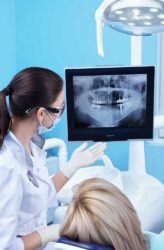

Overview
Our dentists use dental X-rays as diagnostic imaging tools to provide a detailed view of the teeth, bones, and soft tissues of the mouth that are not visible to the naked eye during a regular dental exam.
What is the purpose of dental X-rays?
Dental X-rays help our dentists diagnose and treat dental problems at an early stage, to help ensure better oral health outcomes. These X-rays can reveal hidden dental structures, cavities, bone loss, and various tooth and gum issues that are otherwise difficult or impossible to see.
Your dentist will determine whether dental crowns are the best restoration option for your situation or if procedures such as dental veneers or dental implants would provide a better treatment outcome.
Types of dental X-rays we use
At our Hamilton dental office, our team uses several different types of dental X-rays depending on the specific purpose of a diagnosis or treatment.
Bitewing X-rays
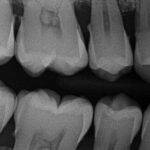 Probably the most common X-ray we use, these show the upper and lower back teeth in a single view. They are used to detect decay between teeth and changes in bone density caused by gum disease. They are also useful for determining the proper fit of a crown or other restorative device.
Probably the most common X-ray we use, these show the upper and lower back teeth in a single view. They are used to detect decay between teeth and changes in bone density caused by gum disease. They are also useful for determining the proper fit of a crown or other restorative device.
Panoramic X-rays
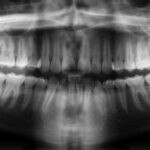 These capture an image of the entire mouth area, showing all the teeth in both upper and lower jaws in a single X-ray. They are useful for detecting impacted teeth, cysts, tumors, jaw disorders, and bone irregularities.
These capture an image of the entire mouth area, showing all the teeth in both upper and lower jaws in a single X-ray. They are useful for detecting impacted teeth, cysts, tumors, jaw disorders, and bone irregularities.
Periapical X-rays
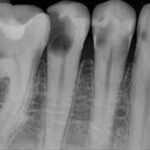 These provide a view of the entire tooth, from the crown to beyond the root where the tooth attaches into the jaw. Periapical X-rays are used to detect dental problems below the gum line or in the jaw, such as impacted teeth, abscesses, cysts, tumors, and bone changes linked to some diseases.
These provide a view of the entire tooth, from the crown to beyond the root where the tooth attaches into the jaw. Periapical X-rays are used to detect dental problems below the gum line or in the jaw, such as impacted teeth, abscesses, cysts, tumors, and bone changes linked to some diseases.
Occlusal X-rays
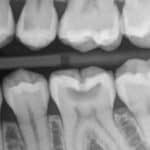 They are larger and show full tooth development and placement in the upper or lower jaw. These are used to detect the presence of extra teeth, teeth that have not yet broken through the gums, jaw fractures, cleft palate, cysts, abnormalities, or growths.
They are larger and show full tooth development and placement in the upper or lower jaw. These are used to detect the presence of extra teeth, teeth that have not yet broken through the gums, jaw fractures, cleft palate, cysts, abnormalities, or growths.
Cone Beam Computed Tomography (CBCT)
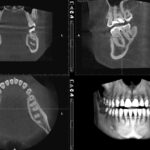 Our most advanced dental X-ray, this technology produces 3D images of the teeth, soft tissues, nerve pathways, and bone in a single scan. It’s used for more complex cases such as implant planning, evaluation of the jaw, sinuses, nerve canals, and nasal cavity, and for detecting and treating orthodontic issues.
Our most advanced dental X-ray, this technology produces 3D images of the teeth, soft tissues, nerve pathways, and bone in a single scan. It’s used for more complex cases such as implant planning, evaluation of the jaw, sinuses, nerve canals, and nasal cavity, and for detecting and treating orthodontic issues.
Orthodontic (Cephalometric) X-rays
 These are commonly used by our orthodontists when planning a treatment schedule because they provide a side view of the face, showing the teeth in relation to the jaw and profile of the individual.
These are commonly used by our orthodontists when planning a treatment schedule because they provide a side view of the face, showing the teeth in relation to the jaw and profile of the individual.
We use only digital dental X-rays
Our office uses only digital X-rays due to the greatly reduced radiation exposure (90% less than traditional film X-rays), instant imaging, better image quality, easy integration and storage with modern dental software and health records, and they allow us to educate our patients about what’s going on with their mouth.
Benefits of dental
X-rays
Dental X-rays offer several valuable benefits to our dentists and patients. One of the primary advantages is their ability to detect dental issues at an early stage. X-rays can reveal conditions like cavities, gum disease, and infections before they become more severe, allowing for timely intervention and treatment.
The most common use for dental X-rays is to check for or confirm the presence of tooth decay in-between teeth.
Additionally, they provide a detailed assessment of tooth and bone health, offering insights into the condition of tooth roots and the surrounding jawbone. This is crucial for diagnosing problems such as abscesses and bone loss.
Dental X-rays are also vital in treatment planning, so that our dentists are able to precisely perform intricate procedures such as extractions, root canals, dental implants and orthodontic treatments where the jawbone and oral nerves must be navigated and accounted for.
Dental X-rays and your safety

All digital dental X-rays we use at our Hamilton clinic are designed and operated with a strong emphasis on patient safety. The use of electronic sensors, customization of exposure settings, immediate imaging, and image enhancement techniques contribute to the safety of digital dental X-rays. Our dental professionals adhere to established principles of radiation safety and quality control to ensure that patients receive the necessary diagnostic information with minimal radiation exposure.
The dental X-ray procedure
The patient is prepared for the X-ray procedure by wearing a lead apron to protect against radiation exposure. A lead thyroid collar may also be provided for added protection of the thyroid gland.
The dental professional will explain the procedure to the patient, including the need to remain still during image acquisition.
Dental X-rays are often done right in the dentist chair or in another area of the clinic.
The patient is positioned in the dental chair, and the X-ray machine (X-ray generator) is adjusted to the appropriate settings based on the type of X-ray needed.
Depending on the specific X-ray being taken, the patient may be asked to bite down on a small, rectangular piece of plastic with a sensor (digital X-rays) or a film (traditional film-based X-rays). This sensor or film captures the X-ray images.
The dental professional, usually a dental hygienist or dental assistant, leaves the treatment room to stand behind a protective barrier.
They activate the X-ray machine, which directs a controlled beam of X-rays at the area of interest (e.g., a specific tooth or section of the mouth).
The X-ray machine emits a brief burst of X-rays, and the sensor or film captures the images.
Depending on the type of X-rays required, the dental professional may reposition the sensor or film to capture images from different angles or perspectives.
Additional X-ray exposures may be taken as needed.
For digital X-rays, the images are processed almost instantly and displayed on a computer screen in the treatment room.
The dental professional reviews the images to ensure they are clear and sufficient for diagnosis.
Additional X-ray exposures may be taken as needed.
The dental professional reviews the X-ray images to assess the patient’s oral health. They look for signs of dental decay, gum disease, bone loss, and other dental conditions.
The X-rays may reveal issues not visible during a clinical examination alone.
The findings from the X-rays are discussed with the patient. If dental issues are identified, the dentist will explain the treatment options and develop a treatment plan.
The X-ray images are documented in the patient’s dental records for reference in future appointments. They become part of the patient’s dental history.
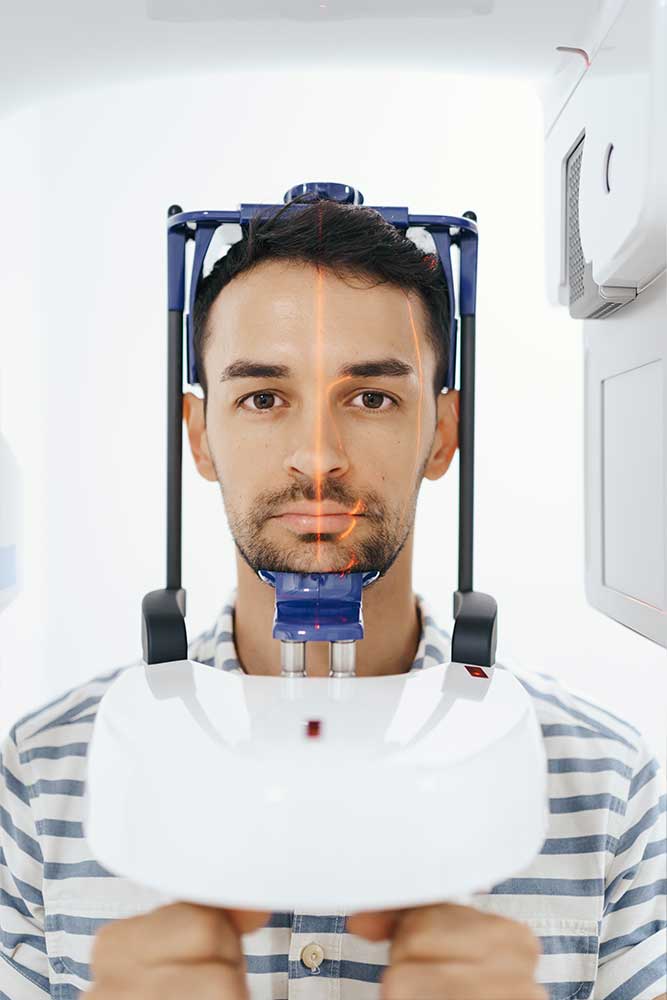
How often do we recommend dental X-rays?
We try to minimize the number of dental X-rays we recommend to our patients unless an issue or treatment would benefit from having X-rays done. As such, the frequency of dental X-rays will vary from patient to patient, often being determined by age, oral health, risk factors, and specific dental issues.
We will generally recommend dental X-rays under the following conditions:

It’s a patients first visit:
This helps us determine a baseline for future comparison and let’s us know the current state of a patient’s oral health so nothing gets missed.

An issue needs diagnosing:
Sometimes there will be a potential issue that needs further investigation with a dental X-ray. It can be something as simple as a cavity between a patient’s teeth.

The patient is a child or adolescent:
We often recommend dental X-rays more frequently to minors because their teeth and jaw structures are still growing and changing, making monitoring more important

Patients with periodontal health problems:
Patients with gum disease may require more X-rays in order to assess the health of their underlying jawbone.

Orthodontic patients:
Patients undergoing orthodontic treatments (braces, aligners, retainers) often need X-rays to monitor the treatment progress and position of teeth and roots. This ensures that the treatment plan adjusted correctly.
Dental X-Ray FAQ
Yes, dental X-rays are safe when used following established guidelines. The radiation exposure is minimal and carefully controlled to prioritize patient safety.
The frequency of X-rays depends on your oral health needs and risk factors. Dentists typically recommend them at routine check-ups or as needed for diagnosis or treatment planning.
Dentists may recommend X-rays during routine check-ups to monitor your oral health and detect any hidden issues. The frequency depends on your individual dental health.
Have questions or concerns about dental X-rays?
Book your free consultation at our
Jackson Square Mall location now.
